


History of Yoga
Lord Shiva is considered to be the symbol or embodiment of supreme consciousness. Parvati represents supreme knowledge. Lord Shiva is the source of all kinds of knowledge like yoga, mantra, tantra, yantra, siddhis etc. Everything has come out from his own will. As for the Yoga is concerned, we discuss about Yoga and Hatha Yoga. Especially Hatha Yoga is known for the awakening of the Shakti or Kundalini. This force or energy is also known as Kundalini Shakti, the cosmic force which lies dormant in all beings. Parvati is regarded as the mother of the whole universe. The individual soul is embodied and bound to the world of name and form, and also liberated from the bondage of the world and united with supreme consciousness through her grace. Out of love and compassion for her children, she imparted her secret knowledge of liberation in the form of tantra. The techniques of yoga have their source in tantra and the two cannot be separated, just as consciousness, Shiva, cannot be separated from energy, Shakti.
Yoga arose at the beginning of human civilization when humankind first realized their spiritual potential and began to evolve techniques to develop it. The yogic science was slowly developed by ancient sages all over the world. The essence of yoga has often been explained by different symbols, analogies and languages. Some traditions believe that yoga was a divine gift revealed to the ancient sages so that humankind could have the opportunity to realize its divine nature.
The first books to refer to yoga were the ancient tantras and later the Vedas. Vedas were heard by the rishis, seers, in states of deep yogic meditation or Samadhi and are regarded as revealed scriptures. It is, however, in the Upanishads that yoga begins to take a more definable shape. These scriptures collectively form Vedanta.
Sage Patanjali’s treatise on raja yoga, the Yoga sutras, codified the first definitive, unified and comprehensive system of yoga. Often called the eight-fold path, it is comprisd of yama (self-restraints), niyama (self-observances), asana, pranayama, pratyahara (disassociation of consciousness from the outside environment), dharana (concentration), dhyana (meditation), and Samadhi (identification with pure consciousness).
Today, in the 21st century, a spiritual heritage is being reclaimed of which yoga is very much a part. While yoga’s central theme remains the highest goal of the spiritual path, yogic practices give direct and tangible benefits to everyone regardless of their spiritual aims.
Yoga was simply a means of maintaining health and well-being in an increasingly stressful society. Asanas do remove the physical discomfort accumulated during a day at the office sitting in a chair, hunched over a desk. Relaxation techniques help to maximize the effectiveness of ever-diminishing time off. In an age of mobile phones, beepers and twenty-four hour shopping, yogic practices make great personal and even business sense.